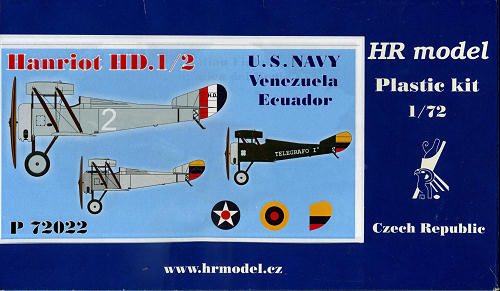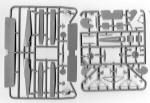
| KIT #: | P72022 |
| PRICE: | 360 Koruna - about $17.25 - from www.hobbyshop.cz |
| DECALS: | Four Options |
| REVIEWER: | Scott Van Aken |
| NOTES: |

| HISTORY |
The new type was ordered into production as a possible replacement for the Nieuport 17, but became “surplus” when it was decided to replace the Nieuport with the SPAD S.7 in the French air service. Some were supplied to the French Navy, a few of which were eventually passed to the U.S. Navy – some naval Hanriots were converted to, or built as, floatplanes with enlarged tail surfaces.
The bulk of early production, however, was diverted to the Belgians, who notoriously had to make do with aircraft unwanted by their allies. With the Belgian fighter squadrons the HD.1 proved surprisingly successful, and the type remained the standard Belgian fighter for the rest of the war. Willy Coppens, the top Belgian ace of the war was the most successful HD.1 pilot.
The type was also supplied in small numbers to the Italians who manufactured it in quantity, and used it to replace not only Nieuports but also SPADs in their service. The type was considered (by the Italians) to be a better all-round fighter than even the SPAD S.XIII and it became the standard Italian fighter, equipping 16 of the 18 operational Italian fighter squadrons by November 1918. Surplus Italian-built Hanriots were used by several countries postwar – including the Swiss.
The U.S. Naval Aircraft Factory built (or possibly modified/converted) 10 HD.1s in the immediate postwar years. These were mainly used as trainers, although they were also involved in experiments with takeoff platforms on warships – they could be fitted with twin guns, and at least one machine had a hydrovane and flotation bags of the type developed for the Royal Navy.
| THE KIT |
 This is a very nicely done kit by HR Model that is typical of what we can expect from some of the more prolific short run kit makers. There are two sprues of nicely molded plastic that have minimal flash, no problems with misaligned molds or with much in the way of ejector pin marks. I like that the fabric representations are quite subdued, just like on the real aircraft.
This is a very nicely done kit by HR Model that is typical of what we can expect from some of the more prolific short run kit makers. There are two sprues of nicely molded plastic that have minimal flash, no problems with misaligned molds or with much in the way of ejector pin marks. I like that the fabric representations are quite subdued, just like on the real aircraft.  US Navy planes from 1923 in an overall light blue grey with aluminum engine cowling. They differ in numbers and the fact that one is armed. An Ecuadoran HD.1 in overall dark green with just a name (Telegrafo I) and rudder stripes is the third option. It also has an aluminum cowling and is unarmed. The Venezuelan version is overall aluminum dope with the forward section in what looks to be unpainted aluinum. This has roundels in six wing positions. It also has a band of stars in its rudder stripes to differentiate it from the Ecuadoran plane. This one is shown armed. The decals are very nicely done
US Navy planes from 1923 in an overall light blue grey with aluminum engine cowling. They differ in numbers and the fact that one is armed. An Ecuadoran HD.1 in overall dark green with just a name (Telegrafo I) and rudder stripes is the third option. It also has an aluminum cowling and is unarmed. The Venezuelan version is overall aluminum dope with the forward section in what looks to be unpainted aluinum. This has roundels in six wing positions. It also has a band of stars in its rudder stripes to differentiate it from the Ecuadoran plane. This one is shown armed. The decals are very nicely doneA strange omission for a WWI era aircraft, is that there is no rigging diagram. You can tell what goes between the outer struts and on the tailplane, but what goes between the gear or between the outer struts and fuselage will require some sleuthing on the internet.
| CONCLUSIONS |
| REFERENCES |
July 2012
Thanks to www.hobbyshop.cz for the preview kit. You can get yours at the link. If you would like your product reviewed fairly and quickly, please contact the editor or see other details in the